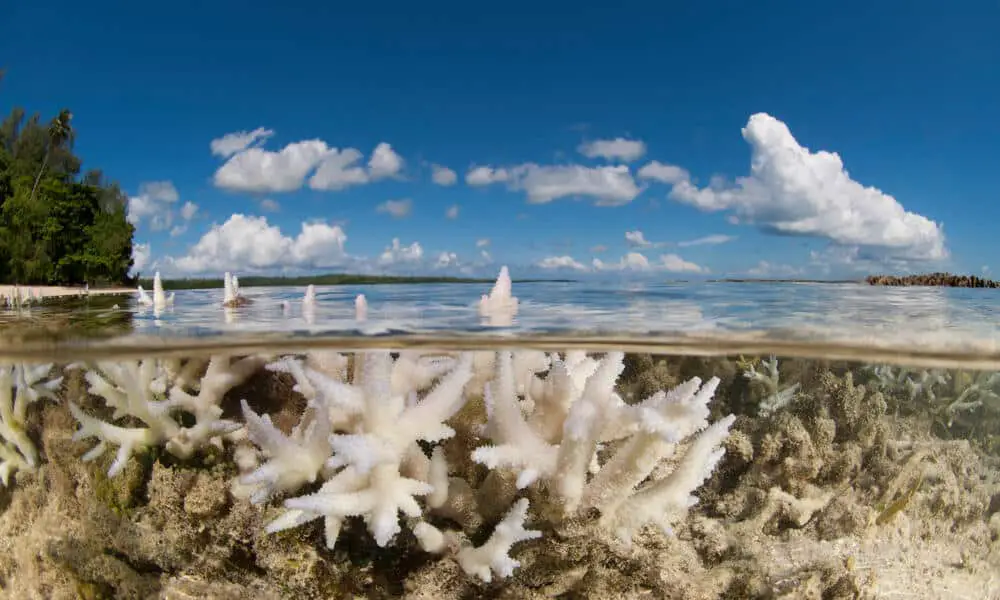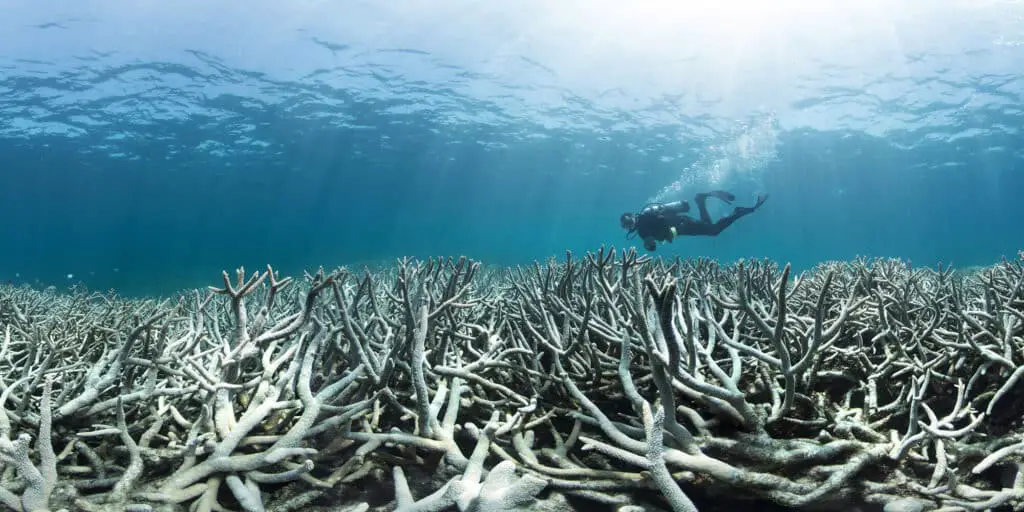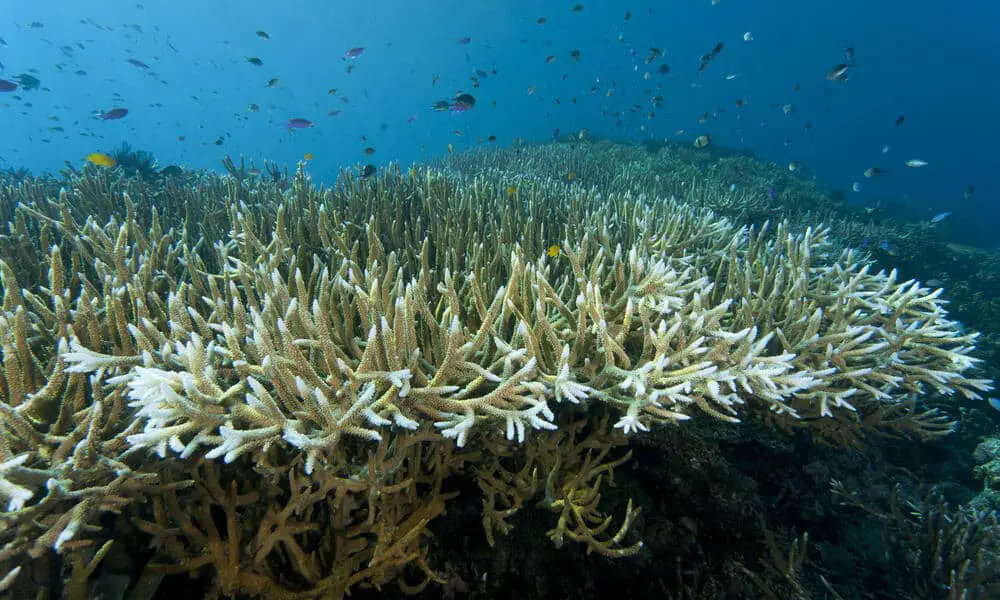What Is The Main Cause Of Coral Bleaching

Introduction
What Is The Main Cause Of Coral Bleaching: Coral bleaching is a distressing phenomenon that poses a grave threat to the world’s coral reefs, which are vital ecosystems supporting a myriad of marine life. This process occurs when corals expel the symbiotic algae known as zooxanthellae that live within their tissues. These algae provide corals with essential nutrients and vibrant colors, making them the vibrant structures we associate with underwater beauty.
The main culprit behind coral bleaching is the rising sea temperatures, driven primarily by climate change. As our planet warms due to increased greenhouse gas emissions, oceans absorb much of this heat. Elevated water temperatures stress coral polyps, leading them to expel the zooxanthellae in a desperate survival response. This expulsion deprives the corals of their main energy source and vibrant pigments, causing them to turn ghostly white.
While temperature-induced stress is the primary trigger, other factors can exacerbate coral bleaching. Pollution, including runoff from agriculture and coastal development, introduces harmful substances into the water, further weakening corals. Ocean acidification, a result of increased carbon dioxide levels, also renders corals more vulnerable.
Understanding the main cause of coral bleaching is crucial, as it enables us to address the root issue of climate change. By reducing greenhouse gas emissions, mitigating pollution, and promoting sustainable practices, we can strive to protect these invaluable marine ecosystems from the dire threat of bleaching and ensure their survival for future generations.

What are the six causes of coral bleaching?
Although some are more common than others, coral bleaching can have a number of causes.
- Temperature.
- Solar Irradiance.
- Subaerial Exposure.
- Sedimentation.
- Fresh Water Dilution.
- Inorganic Nutrients.
- Xenobiotics.
- Epizootics.
Coral bleaching, a phenomenon plaguing our oceans, results from a delicate interplay of natural and anthropogenic factors. The six primary causes of coral bleaching are rooted in environmental stressors:
- Temperature Stress: Elevated sea temperatures are a significant trigger for bleaching events. When ocean waters become too warm, corals expel the symbiotic algae living in their tissues, causing them to turn white. This disrupts the vital nutrient exchange between coral polyps and algae.
- Light Intensity and Duration: Excessive sunlight can lead to bleaching, particularly in shallow waters where corals are exposed to intense sunlight for extended periods. High light levels exacerbate the stress experienced by corals.
- Nutrient Pollution: Runoff from agricultural and urban areas introduces excess nutrients into coastal waters. This promotes the growth of harmful algae, which can overtake and smother corals, impeding their ability to recover.
- Ocean Acidification: As the concentration of carbon dioxide in the atmosphere increases, the oceans absorb a significant portion of it. This leads to a decrease in pH levels, making the water more acidic. Acidic conditions inhibit the growth of coral skeletons, weakening the structure of the reef.
- Pollution and Sedimentation: Chemical pollutants, such as oil and toxins from industrial processes, can disrupt the delicate balance of the coral ecosystem. Sedimentation, caused by activities like construction and deforestation, can smother corals and block sunlight.
- Overfishing and Destructive Practices: Overfishing disrupts the delicate balance of the reef ecosystem, as certain fish species play critical roles in maintaining a healthy coral environment. Additionally, destructive practices like dynamite fishing or anchor damage physically harm corals.
What type of pollution causes coral bleaching?
Pesticides can affect coral reproduction, growth, and other physiological processes. Herbicides, in particular, can affect the symbiotic algae (plants). This can damage their partnership with coral and result in bleaching.
Coral bleaching is primarily caused by two types of pollution: thermal pollution and chemical pollution.
- Thermal Pollution: The most significant contributor to coral bleaching is thermal pollution, primarily driven by climate change. Rising global temperatures lead to increased sea surface temperatures, which stress coral reefs. Corals have a symbiotic relationship with microscopic algae called zooxanthellae, which provide them with nutrients and vibrant colors. However, when water temperatures exceed their tolerance threshold, corals expel these algae, resulting in a loss of color and nutrients, hence the term “bleaching.” Prolonged exposure to elevated temperatures can lead to coral death.
- Chemical Pollution: Chemical pollutants from various sources, including runoff from agriculture, industrial processes, and sewage discharge, can also contribute to coral bleaching. These pollutants introduce excess nutrients, like nitrogen and phosphorus, into the marine environment, leading to algal overgrowth. When algae outcompete corals for space and resources, it can hinder the corals’ ability to recover from stress and contribute to their bleaching and eventual decline.
Both thermal and chemical pollution are exacerbated by human activities, emphasizing the need for global efforts to mitigate climate change, reduce pollution, and protect these fragile ecosystems.
What causes coral bleaching PDF?
Coral bleaching can be caused by a wide range of environmental stressors such as pollution, oil spills, increased sedimentation, extremes in sea temperatures, extremes in salinity, low oxygen, disease, and predation.
When coral polyps, the tiny organisms that make up coral reefs, are exposed to prolonged periods of excessively high water temperatures, they expel the symbiotic algae called zooxanthellae that live within their tissues. These algae provide corals with essential nutrients through photosynthesis, as well as vibrant colors. However, under stress, corals expel these algae, causing the corals to lose their color and eventually starve.
Other factors that can exacerbate coral bleaching include increased solar radiation, pollution from land runoff, and ocean acidification. Pollution introduces additional stress by introducing harmful chemicals and sediments into the water, further compromising the health of coral reefs.
Human activities, particularly the burning of fossil fuels and deforestation, contribute to global climate change, which in turn raises sea temperatures and exacerbates coral bleaching events. To mitigate coral bleaching, it is imperative that we address these underlying causes through sustainable environmental practices, reduce carbon emissions, and take measures to protect and preserve these invaluable ecosystems.
Where is coral bleaching most common?
Coral reef provinces have been permanently damaged by warm sea temperatures, most severely in the Indian Ocean. Up to 90% of coral cover has been lost in the Maldives, Sri Lanka, Kenya, and Tanzania and in the Seychelles during the massive 1997–98 bleaching event.
Coral bleaching is most common in regions with specific environmental conditions that make coral reefs particularly vulnerable. Here are some of the key areas where coral bleaching is most prevalent:
- Tropical Oceans: Coral reefs are predominantly found in tropical oceans, particularly in the Coral Triangle (located in the western Pacific Ocean) and the Caribbean Sea. These regions are hotspots for coral diversity and are frequently affected by coral bleaching events due to their warm waters.
- High Sea Surface Temperatures: Coral bleaching is most common when sea surface temperatures rise above the normal seasonal range. This often occurs during El Niño events, where ocean temperatures in the Pacific Ocean become unusually warm. The Indian Ocean also experiences temperature anomalies contributing to bleaching.
- Human Activities: Areas near densely populated coastal regions are more prone to coral bleaching due to human-induced stressors. Pollution from runoff, overfishing, and coastal development can further weaken corals, making them more susceptible to bleaching.
- Coral Reefs at Shallow Depths: Shallow-water coral reefs are more exposed to temperature fluctuations, making them more susceptible to bleaching. Deeper reefs can act as refuges during bleaching events.
Coral bleaching is a global issue, but its severity varies depending on local environmental factors and human impact. Efforts to reduce greenhouse gas emissions, improve water quality, and protect coral reefs are essential to mitigate the frequency and severity of coral bleaching in these vulnerable regions.
Is coral bleaching caused by ocean acidification?
Greenhouse gas emissions are the main cause of ocean acidification and the increases in sea temperature that cause coral bleaching. Any efforts to reduce emissions will bring benefits both on land and at sea. However, global greenhouse gas emissions have risen steadily in recent years.
Coral bleaching is primarily caused by rising sea temperatures, not ocean acidification. While both factors are linked to human-induced climate change, they have distinct impacts on coral reefs. Coral bleaching occurs when corals expel the symbiotic algae (zooxanthellae) living in their tissues due to stress, which turns them white.
This process weakens the corals and can eventually lead to their death if normal conditions do not return. The main driver of coral bleaching is the increasing sea surface temperatures caused by the absorption of excess greenhouse gases in the atmosphere.
On the other hand, ocean acidification results from the absorption of excess carbon dioxide by seawater. This leads to a decrease in the pH levels of the ocean, making it more acidic. While ocean acidification can harm marine organisms with calcium carbonate shells or skeletons, like some types of plankton, mollusks, and certain species of algae, it is not the direct cause of coral bleaching.
Both phenomena are interrelated and stem from the same root cause: human activities that release excessive amounts of greenhouse gases into the atmosphere. Addressing these issues necessitates global efforts to mitigate climate change through reducing carbon emissions and implementing sustainable practices to safeguard the future of coral reefs and marine ecosystems.
What are 8 stress factors that cause coral bleaching?
Coral reef bleaching is caused by various anthropogenic and natural variations in the reef environment including sea temperature, solar irradiance, sedimentation, xenobiotics, subaerial exposure, inorganic nutrients, freshwater dilution, and epizootics.
Coral bleaching is a critical threat to the world’s coral reefs, and it can be attributed to a variety of stressors. Here are eight significant factors that contribute to coral bleaching:
- Elevated Sea Temperatures: High water temperatures are the primary cause of coral bleaching. When waters become excessively warm, corals expel the colorful algae living in their tissues, which leads to their bleached appearance.
- Solar Radiation: Intense sunlight can exacerbate the stress on corals, especially when combined with high temperatures. This can occur during heatwaves or periods of unusually clear skies.
- Ocean Acidification: While not a direct cause of bleaching, increased levels of carbon dioxide in the atmosphere lead to ocean acidification. This makes it more challenging for corals to build their calcium carbonate skeletons, making them more vulnerable to other stressors.
- Pollution: Runoff from coastal areas can introduce pollutants, such as agricultural chemicals and wastewater, into the ocean. These contaminants can stress corals and weaken their resistance to bleaching.
- Sedimentation: Excessive sedimentation can smother corals, reducing the amount of light they receive for photosynthesis. This can occur due to coastal construction, deforestation, or erosion.
- Disease Outbreaks: Corals can be more susceptible to diseases when stressed. Elevated temperatures and other environmental factors can facilitate the spread of pathogens within coral colonies.
- Overfishing: Removing key herbivores, like parrotfish and sea urchins, disrupts the delicate balance of the reef ecosystem. This can lead to overgrowth of algae, which competes with corals for space and resources.
- Extreme Weather Events: Hurricanes, typhoons, and cyclones can physically damage corals and introduce additional stress through factors like increased water turbulence and sedimentation.
What chemical causes coral bleaching?
Oxybenzone
Oxybenzone — a chemical linked to coral bleaching — transforms from a UV-blocking agent into one that damages cells when exposed to light.
The chemical that primarily causes coral bleaching is excess carbon dioxide (CO2) in the atmosphere, which leads to a phenomenon known as ocean acidification. When CO2 is absorbed by seawater, it undergoes a chemical reaction that lowers the pH levels of the ocean, making it more acidic. While ocean acidification itself doesn’t directly cause coral bleaching, it weakens the corals’ ability to build and maintain their calcium carbonate skeletons.
The main driver of coral bleaching, however, is not a chemical, but rather a physical factor: elevated sea surface temperatures. When waters become excessively warm, corals experience thermal stress. In response, they expel the colorful symbiotic algae (zooxanthellae) that live within their tissues. This loss of algae leads to the bleached appearance of corals.
Additionally, high levels of nutrients from agricultural runoff and other human activities can exacerbate the impacts of bleaching. These nutrients can lead to algal overgrowth, further stressing corals by competing for space and resources.
Overall, while chemical changes in the ocean play a role in coral bleaching through processes like ocean acidification, it is the physical factors like elevated temperatures that directly trigger this damaging phenomenon. Addressing the root causes of climate change and reducing carbon emissions remains crucial in preserving the health of coral reefs worldwide.
Why are elevated sea water temperatures a problem for corals?
Elevated sea water temperatures pose a significant threat to corals due to their sensitivity to changes in their environment. Corals are highly evolved marine organisms that form a delicate symbiotic relationship with microscopic algae called zooxanthellae. These algae provide corals with essential nutrients through photosynthesis, while the corals offer shelter and nutrients in return.
When sea temperatures rise beyond a certain threshold, typically during prolonged periods of heatwaves, corals become stressed. In response, they expel the zooxanthellae from their tissues. These algae give corals their vibrant colors, so when they’re expelled, the corals appear pale or bleached. This process deprives corals of their primary source of nutrition and weakens them.
Prolonged or severe bleaching events can lead to coral mortality, disrupting entire reef ecosystems. Without their coral hosts, many species of fish, invertebrates, and other marine organisms lose their habitats, which can have cascading effects up the food chain.
Weakened and bleached corals are more susceptible to diseases and other stressors, making it harder for them to recover. As ocean temperatures continue to rise due to climate change, the frequency and severity of bleaching events are increasing, posing a serious threat to the long-term survival of coral reefs worldwide. Addressing the root causes of climate change is crucial for the preservation of these vital marine ecosystems.

Conclusion
Coral bleaching is an alarming consequence of our changing climate, primarily driven by rising sea temperatures resulting from the accumulation of greenhouse gases. This phenomenon threatens the very existence of coral reefs, which are not only breathtakingly beautiful but also essential to the health of our planet’s oceans.
The main cause of coral bleaching serves as a stark reminder of the urgent need to combat climate change. While the process itself may be triggered by elevated water temperatures, it is exacerbated by a host of other factors, including pollution and ocean acidification, all of which are intrinsically linked to human activities. This underscores the critical role we play in both the problem and its solution.
To protect these vulnerable ecosystems, concerted efforts must be made at local, national, and global levels. This includes reducing carbon emissions, transitioning to renewable energy sources, implementing sustainable land-use practices, and establishing marine protected areas.
Ultimately, the main cause of coral bleaching is a stark reminder of the interconnectedness of Earth’s ecosystems and the profound impact of human actions. Addressing coral bleaching is not just about safeguarding coral reefs; it’s about safeguarding the future of our planet and the myriad species that depend on these underwater havens for their survival.



